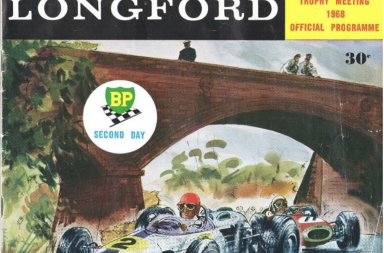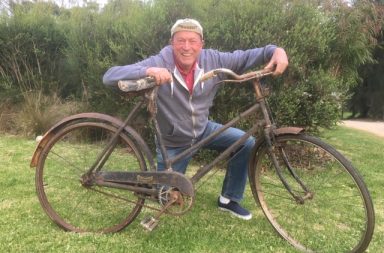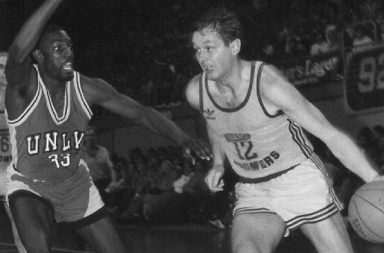Written 2005
Of all the teaching aids that Phil Higgins takes on his annual science excursions into the outback, the spherical conveyance is his secret weapon.
The ‘flying scientist’ first used it as a motivation tool when he landed at Tilmouth roadhouse on the Tanami desert, in the remote north of Western Australia.
Unloading his test tubes, transistors and microscopes from his light plane, he sensed that the aboriginal kids were only mildly curious about his scientific knick-knacks.
A Collingwood seconds football player from the 1960s, Higgins always carries an Aussie Rules ball in his kit, and he knew this was the time to exploit the ball’s mystical powers for the purpose of enlightenment.
As soon as they saw the footy, he knew he had picked the mood of the meeting – his bush classroom was buzzing with wannabe Wanganeens.
A couple of 44 gallon drums became goalposts, and the kids kept score on graph paper.
The game became the lesson. Each goal prompted questions of addition and multiplication. Shots from angles became algebra on the run.
Higgins is a master at wrapping numeracy, literacy and logic in fun.
He has timing, too.
One Melbourne Cup week he landed at Maranthona station in far West Queensland, and found the kids were obsessed with the gee gees.
Sensing an opportunity for some mathematical tuition, he helped them to measure a racetrack around the station and to build hobby horses.
After they raced around their course, Higgins had them working out their speeds and they learnt how much science is a part of their lives.
The ‘flying scientist’ is known far and wide through the bush telegraph of the outback.
They call him Phiggles, because he and wife Suzanne fly their hired plane between outback airstrips, usually landing at stations right on breakfast time.
Their strategy is to start the day by causing excitement among the kids and heighten the feeling of a magical experience.
Anything can happen in a day when Phiggles drops in.
Lights start flashing, chemicals react, goals get kicked, cricket games break out.
None of the lessons are formal.
Kids are usually barefoot.
‘Laboratories’ can be station buildings or shearers quarters or as simple as rolled out sheets of paper on tables where fleeces are thrown.
Over the past five years, Phil and Suzanne have taken science to more than a thousand of Australia’s most isolated children.
When they set up Cameron’s Corner one year, a family drove 350km from Tibooburra – a round trip of almost seven hours – so their children could join in.
Each year’s trip has been to specific part of the inland – the arid north of South Australia in the first year, the back country of New South Wales another year, up through the Northern Territory and last year across to the Kimberley.
This year they will go to the tropics for the first time.
When they take off next month from their home near Churchill in Gippsland, Victoria, their course will be for Mt Isa, from where they will drop in on stations and towns around central north Queensland, including the Gulf of Carpentaria.
They will be away for seven weeks, working with the network created by the School of the Air.
They will reach kids who have probably only ever experienced science from a teacher on the other end of a radio or computer network.
“The looks on their faces when a radio circuit lights up, or something happens in an experiment, is something else,” Phil said this week.
“The best thing about science is that you don’t need to be Einstein. You just need to observe and to be able to link one thing with another.”
Phil and Suzanne don’t get any government funding for their annual trips. Their only support is from Australia Post, which pays for the light plane and fuel.
“It’s not about money,” he says. “It’s about satisfying a need.”
Phil has been a University science teacher in his native Latrobe Valley for more than 30 years.
But the death from cancer in 1997 of his eldest daughter forced him to re-evaluate what he was doing.
“I felt I needed to do something meaningful – I just didn’t know what it was.”
Responding to an advertisement for scientist-in-resident at a country primary school, he realised how difficult it was for bush children to get a hands-on scientific experience.
He dreamt of taking science to the outback, but first he had to learn to fly.
On a training flight with Latrobe Valley Aero Club he called in at a dusty airstrip south of Lake Eyre in South Australia, where kids and parents from seven surrounding stations came to meet the ‘flying scientist.’
When he brought out a microscope and invited kids to examine whatever they want, he found their imaginations ran wild.
They returned with dead lizards, snakes, ants, feathers and flowers.
At Southampton Downs in central Queensland, the kids were fascinating by hair.
They made up slides with the hair of dogs, cats, kangaroos, wallabies, even goats.
“They love the froth ‘n bubble, the interaction.
“It’s stuff they can’t get out text books.”
The kids tackle any aspect of science – chemistry, biology, physics, mechanics, engineering or optics – though most get excited by electronics.
He draws a diagram of how a circuit should look, and challenges the kids to build their own.
When a light shines or motor runs, they get an instant reward.
“The kids surprise themselves,” says Suzanne.
“We’ve noticed with aboriginal children that they are very strong visually.
“They see a diagram, the battery, the switch, the wire, the diode and – after they look at it and handle it – they know how to do it.”
At one station in Western Australia, an aboriginal family – mum, dad, uncle, auntie and four kids – walked for hours to come to a class.
The father explained later that the uncle had heard of the legendary Phiggles, and had insisted that the children come to experience his science lesson.



